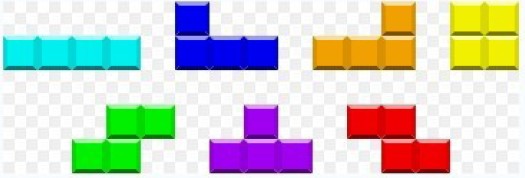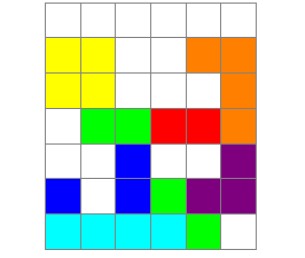当前你的浏览器版本过低,网站已在兼容模式下运行,兼容模式仅提供最小功能支持,网站样式可能显示不正常。
请尽快升级浏览器以体验网站在线编辑、在线运行等功能。
3224:Exciting Time
题目描述
It’s exciting time! Now let’s consider the most famous video game in the world: Tetris.
Tetris is a puzzle video game originally designed and programmed by Alexey Pajitnov. It was created on June 6, 1984. The game is available for nearly every video game console and computer operating system, as well as devices such as graphing calculators, mobile phones, portable media players, PDAs and even as an Easter egg on non-media products like oscilloscopes.

Some random tetrominoes (shapes each composed of four square blocks) will fall down sequentially into the playing field. The objective of the game is to manipulate those tetrominoes, by moving each one sideways and/or rotating it, with the aim of creating a horizontal line of blocks without gaps. When such a line is created, it disappears, and any block above that line will fall until it hits an obstacle. See the sample test case for further details.
Tetris game manuals refer to the seven one-side tetrominoes in Tetris as I, J, L, O, S, T and Z (due to their resembling letters of the alphabet). All are capable of single and double clears. I, J and L are able to clear triples. Only the I tetromino has the capacity to clear four lines simultaneously, and this is referred to as a “tetris”.
Wikipedia (http://en.wikipedia.org/wiki/Tetris)
The scoring formula for the majority of Tetris products is based on the idea that more difficult line clears should be awarded more points. Specifically, a single clear will be awarded 100 points, 250 points for a double clear, 400 points for a triple clear, and 1000 points for a “tetris”.
Now you are given the width of the playing field and a sequence of tetrominoes with the position and degrees it rotated. The task is to calculate how many points will be awarded.
You can assume the playing field is high enough, so that tetrominoes will not overlap each other even when a tetromino is created at the top of the playing field.
Tetris is a puzzle video game originally designed and programmed by Alexey Pajitnov. It was created on June 6, 1984. The game is available for nearly every video game console and computer operating system, as well as devices such as graphing calculators, mobile phones, portable media players, PDAs and even as an Easter egg on non-media products like oscilloscopes.

Some random tetrominoes (shapes each composed of four square blocks) will fall down sequentially into the playing field. The objective of the game is to manipulate those tetrominoes, by moving each one sideways and/or rotating it, with the aim of creating a horizontal line of blocks without gaps. When such a line is created, it disappears, and any block above that line will fall until it hits an obstacle. See the sample test case for further details.
Tetris game manuals refer to the seven one-side tetrominoes in Tetris as I, J, L, O, S, T and Z (due to their resembling letters of the alphabet). All are capable of single and double clears. I, J and L are able to clear triples. Only the I tetromino has the capacity to clear four lines simultaneously, and this is referred to as a “tetris”.
Wikipedia (http://en.wikipedia.org/wiki/Tetris)
The scoring formula for the majority of Tetris products is based on the idea that more difficult line clears should be awarded more points. Specifically, a single clear will be awarded 100 points, 250 points for a double clear, 400 points for a triple clear, and 1000 points for a “tetris”.
Now you are given the width of the playing field and a sequence of tetrominoes with the position and degrees it rotated. The task is to calculate how many points will be awarded.
You can assume the playing field is high enough, so that tetrominoes will not overlap each other even when a tetromino is created at the top of the playing field.
输入解释
There are multiple test cases.
The first line of the input contains an integer T, meaning the number of the test cases.
The first line of each case contains two integers W and N (1≤W ≤30000, 0≤N≤30000), where W is the width of the playing field and N is the number of tetrominoes.
Then N lines follow. Each line contains the description of a single tetromino. The type of the tetromino (I, J, L, O, S, T or Z) comes first, followed by an integer ID, meaning the id of the column of the leftmost square block in the tetromino. The columns are numbered in increasing order from left to right, beginning with zero. The last number shows the degree the tetromino should be rotated; it can only be 0, 90, 180 or 270. The one with 0-degree rotation is shown in the above picture.
Note that the rotate operations are in clockwise. And the order of tetrominoes is the same as the input sequence.
See the sample input for further details.
The first line of the input contains an integer T, meaning the number of the test cases.
The first line of each case contains two integers W and N (1≤W ≤30000, 0≤N≤30000), where W is the width of the playing field and N is the number of tetrominoes.
Then N lines follow. Each line contains the description of a single tetromino. The type of the tetromino (I, J, L, O, S, T or Z) comes first, followed by an integer ID, meaning the id of the column of the leftmost square block in the tetromino. The columns are numbered in increasing order from left to right, beginning with zero. The last number shows the degree the tetromino should be rotated; it can only be 0, 90, 180 or 270. The one with 0-degree rotation is shown in the above picture.
Note that the rotate operations are in clockwise. And the order of tetrominoes is the same as the input sequence.
See the sample input for further details.
输出解释
For each test case you should output three lines.
The first line contains the case number.
The second line contains a single integer which is the points awarded in total.
The third line contains W integers, the i-th number is the height of the highest square block in the i-th column, separated by a single whitespace.
The first line contains the case number.
The second line contains a single integer which is the points awarded in total.
The third line contains W integers, the i-th number is the height of the highest square block in the i-th column, separated by a single whitespace.
输入样例
2 6 9 I 0 0 S 3 90 T 4 270 J 0 0 J 2 90 S 0 0 Z 3 0 O 0 0 L 4 270 1 1 I 0 90
输出样例
Case #1: 200 6 6 4 4 6 6 Case #2: 1000 0
提示
The final state of the game field is shown below.
来自杭电HDUOJ的附加信息
| Recommend | zhuweicong |
最后修改于 2020-10-25T23:01:21+00:00 由爬虫自动更新
共提交 0 次
通过率 --%
| 时间上限 | 内存上限 |
| 8000/4000MS(Java/Others) | 32768/32768K(Java/Others) |
登陆或注册以提交代码
